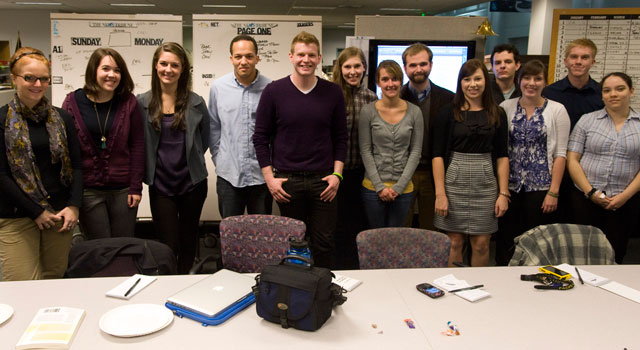Page 93 • (1,417 results in 0.025 seconds)
-
data document temperature increases on both ocean and land surfaces, and in both urban and rural environments. Scientists expect climate patterns to continue to fluctuate from year-to-year, such as the El Nino – La Nina climate oscillation, but global mean temperatures are expected to rise 0.2 to 1.0 º F per decade through the 21st century (Mote et al., 2009; IPCC, 2007). In the Pacific Northwest, increased temperatures will bring rising sea levels, reduced snowpack and more extreme weather
-

received a “gold” designation and was ranked the sixth most “military friendly” institution among private universities offering doctorate degrees.Institutions earning the Military Friendly School designation were evaluated using both public data sources and responses from a proprietary survey. More than 1,800 schools participated in the 2023-2024 survey with 665 earning special awards for going above the standard. Methodology, criteria, and weightings were determined by Viqtory with input from the
-

and student outcomes. Money.com analyzed dozens of data points, including graduation rates, cost of attendance, financial aid and alumni salaries and concluded that PLU offers an experience where students’ tuition and time are likely to be rewarded.This summer, PLU was also named a 2024 “Hidden Gem” by College Raptor, a leading college planning platform. This selection recognizes PLU as one of the best colleges in the country, based on a combination of factors, including retention rates
-
Engineering Program RequirementsIn order to earn a PLU degree through the Dual Degree program, the following requirements must be met: (1) Completion of the following science and mathematics courses (44 hours) MATH 151, 152, 253 (12 semester hours) MATH 351 or PHYS 354 (4 semester hours) PHYS 153 and 163, 154 and 164, and 223 (14 semester hours) CHEM 115 and 116 (8 semester hours) ENGR 131 (2 semester hours) DATA 133 or CSCI 144 (4 semester hours) More Information Dual-Degree Home Academic
-
. Keck Foundation of Los Angeles and saw “first light” in 2000. It houses an automated 16-inch Schmidt-Cassegrain reflecting telescope built by Meade Instruments. In addition to the familiar mode of direct observations through an eyepiece, data at the PLU observatory can be collected digitally through either a Santa Barbara Instruments Group CCD camera or Celestron NexImage Planetary Imager mounted to the telescope. The W.M. Keck Foundation is best known for supporting the construction of much larger
-
camera and then use the spectrometer to explore the wave properties of light. In this project, the RISE researcher will analyze pre/post instruction multiple choice survey data on students’ concepts of wave properties and qualitatively analyze the students’ written responses to open ended assignment prompts. Results will be used to evaluate the curriculum effectiveness and direct further curriculum development and improvements. Faculty mentors: Drs. Guy, Buckley, and Offerdahl Read Previous APS/IBM
-
and electromechanical technicians, law enforcement and security technology professionals, cybersecurity professionals, data scientists as well as those interested in STEM-related policy issues such as climate change, emerging technologies, global health, and the supply chain among others at home and abroad! During our virtual career fair, you will have the opportunity to engage with Foreign Service and Civil Service professionals across a broad range of STEM fields. Learn how your STEM background
-

interns discuss celestial image processing. Kop is making light curves, showing how the brightness of several variable stars changes over time. Ordaz captured images of globular clusters, constructing diagrams based on temperature and luminosity to estimate the age of these ancient clusters.STUDENT VOICES: Kop and Ordaz share their summer research from the W. M. Keck Observatory Julian Kop ’24 classifies variable star systems, data processing and modeling. “Astronomy and Astrophysics have been my
-
electives for deeper study in the process of innovation, creativity, problem solving, and related proficiencies: ARTD 202: 3D Design (4) ARTD 310: Graphic Design 3 (4) BUSA 340: Non-Profit Management (4) BUSA 358: Entrepreneurship (4) COMA 361: Public Relations: Principles and Practices (4) DATA 133: Introduction to Computational and Data Science (4) CSCI 144: Introduction to Computer Science (4) ENGL 323: Writing for Public and Professional Settings (4) HIST 121: History in Video Games (4) HIST 247
-

become reporters for the night—writing, tweeting, and taking photos for the News Tribune at various campaign parties around the Puget Sound, inputting data as it comes in at news stations like KOMO and Q13, and, new this year, shadowing reporters for Olympia’s TVW. There’s no easy way to capture the energy and excitement at these events—but that’s what students who are out at the election parties are asked to do. “It’s a free for all. It’s super high energy,” said business finance and economics
Do you have any feedback for us? If so, feel free to use our Feedback Form.


